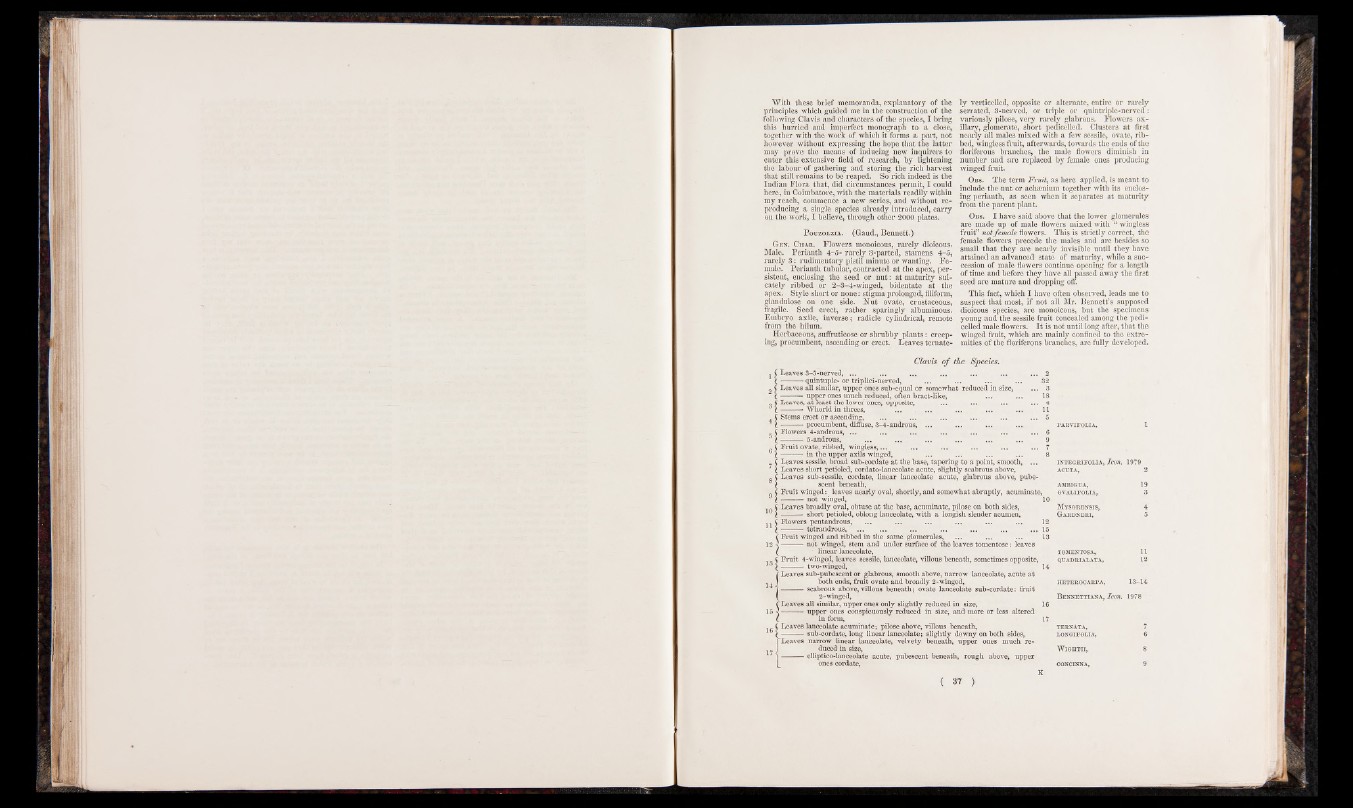
With these brief memoranda, explanatory of the
principles which guided me in the construction of the
following Clavis and characters of the species, I bring
this hurried and imperfect monograph to a close,
together with the work of which it forms a part, not
however without expressing the hope that the latter
may prove the means of inducing new inquirers to
enter this extensive field of research, by lightening
the labour of gathering and storing the rich harvest
that still remains to be reaped. So rich indeed is the
Indian Flora that, did circumstances permit, I could
here, in Coimbatore, with the materials readily within
my reach, commence a new series, and without reproducing
a single species already introduced, can y
on the work, I believe, through other 2000 plates.
P ouzobz ia. (Gaud., Bennett.)
Gen. Char. Flowers monoicous, rarely dioicous.
Male. Perianth 4-5- rarely 3-parted, stamens 4-5,
rarely 3: rudimentary pistil minute or wanting. F e male.
Perianth tubular, contracted at the apex, persistent,
enclosing the seed or n u t: at maturity sul-
cately ribbed or 2-3-4-winged, bidentate at the
apex. Style short or none: stigma prolonged, filiform,
glandulose on one side. Nut ovate, crustaceous,
fragile. Seed erect, rather sparingly albuminous.
Embryo axile, inverse; radicle cylindrical, remote
from the hilum.
Herbaceous, suffruticose or shrubby plants: creeping,
procumbent, ascending or erect. Leaves ternately
verticelled, opposite or alternate, entire or rarely
serrated, 3-nerved, or triple or quintriple-nerved:
variously pilose, very rarely glabrous. Flowers axillary,
glomerate, short pedicelled. Clusters at first
nearly all males mixed with a few sessile, ovate, ribbed,
wingless fruit, afterwards, towards the ends of the
floriferous branches, the male flowers diminish in
number and are replaced by female ones producing
winged fruit.
Obs. The term Fruit, as here applied, is meant to
include the nut or achsenium together with its enclosing
perianth, as seen when it separates at maturity
from the parent plant.
Obs. I have said above that the lower glomerules
are made up of male flowers mixed with “ wingless
fruit” not female flowers. This is strictly correct, the
female flowers precede the males and are besides so
small that they are nearly invisible until they have
attained an advanced state of maturity, while a succession
of male flowers continue opening for a length
of time and before they have all passed away the first
seed are mature and dropping off.
This fact, which I have often observed, leads me to
suspect that most, if not all Mr. Bennett’s supposed
dioicous species, are monoicous, but the specimens
young and the sessile fruit concealed among the pedicelled
male flowers. I t is not until long after, that the
winged fruit, which are mainly confined to the extremities
of the floriferous branches, are fully developed.
Clavis o f the Species.
C Leaves 3-5-nerved, ...
I -------- quintuple- or triplici-nerved,
C Leaves all similar, upper ones sub-equal or somewhat reduced
t -------- upper ones much reduced, often bract-like,
( Leaves, at least the lower ones, opposite,
£ --------Whorld in threes, .............
( Stems erect or ascending,
l -------- procumbent, diffuse, 3-4-androus, ,
C Flowers 4-androus, ...
( -------- 5-androus,
{ Fruit ovate, ribbed, wingless,...
I -------- in the upper axils winged,
( Leaves sessile, broad sub-cordate at the base, tapering to a point, smooth,
( Leaves short petioled, cordato-lanceolate acute, slightly scabrous above,
C Leaves sub-sessile, cordate, linear lanceolate acute, glabrous above, pube-
£ scent beneath,
l Fruit winged: leaves nearly oval, shortly, and somewhat abruptly, acuminate,
l -------- not winged, 10
( Leaves broadly oval, obtuse at the base, acuminate, pilose on both sides,
l —----- short petioled, oblong lanceolate, with a longish slender acumen,
C Flowers pentandrous, ... ... ... ... ... ... 12
l -------- tetrandrous, ................ ... ... ... ... ... 15
f Fruit winged and ribbed in the same glomerules, ... ... ... 13
<-------- not winged, stem and under surface of the leaves tomentose: leaves
( ■ linear lanceolate,
C Fruit 4-winged, leaves sessile, lanceolate, villous beneath, sometimes opposite,
£ --------- two-winged, 14
[ Leaves sub-pubescent or glabrous, smooth above, narrow lanceolate, acute at
J both ends, fruit ovate and broadly 2-winged,
1 -------- scabrous above, villous beneath; ovate lanceolate sub-cordate: fruit
( 2-winged,
(Leaves all similar, upper ones only slightly reduced in size, 16
■<-------- upper ones conspicuously reduced in size, and more or less altered
( in form, 17
C Leaves lanceolate acuminate; pilose above, villous beneath,
( -------- sub-cordate, long linear lanceolate; slightly downy on both sides,
f Leaves narrow linear lanceolate, velvety beneath, upper ones much reduced
in size,
] -------- elliptico-lanceolate acute, pubescent beneath, rough above, upper
(_ ones cordate,
K
FARVIFOLIA, 1
INTEGRIFOLIA, Icon. 1979
ACUTA, 2
AMBIGUA, 19
OVALIFOLIA, 3
Mtsorensis, 4
Gardneri, 5
TOMENTOSA, 11
QUADRIAXiATA, 12
HETEROCARPA, 13 -1 4
B en n ettian a, Jeon. 1978
TERNATA, 7
LONGIFOLIA, 6
WlGHTH, 8
CONCINNA, 9